Bathroom Readers' Institute's Blog, page 163
August 12, 2013
It’s a Fake!
The moral of this story could be “Don’t believe everything you read,” because not only do writers make occasional mistakes, some writers intentionally insert fake facts into their works of non-fiction.
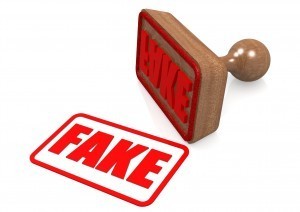 Authors or publishers have a lot of reasons for inserting the occasional fake fact in an otherwise rigorously researched reference book—they may be laying a “copyright trap” to see if anybody uses their book without giving credit. Or sometimes they just do it because it’s fun to trick people.
Authors or publishers have a lot of reasons for inserting the occasional fake fact in an otherwise rigorously researched reference book—they may be laying a “copyright trap” to see if anybody uses their book without giving credit. Or sometimes they just do it because it’s fun to trick people.
FAKE SONG. Joel Whitburn compiles music chart history books based on Billboard’s many charts, which go back to the 1930s. A number of his books note a very obscure song called “The Song of Love” recorded by bandleader Ralph Marterie. Whitburn says the song debuted and peaked at #84 on the pop chart for the week of December 26, 1955. However, Marterie never recorded “The Song of Love.” Nor did Billboard put out a chart the week of December 26, 1955. Whitburn included it to track just how far and by whom his research goes. (Ralph Marterie, however, was a real bandleader and made several recordings in the 1950s.)
FAKE FACT. In 1977, Fred L. Worth wrote The Complete Unabridged Super Trivia Encyclopedia. Since there are lots of other trivia books out there (Really?), Worth wanted to protect the hard work he’d done compiling his book, so he included one fake fact in his book—a “gotcha” in case he ever saw that “fact” in another book. Seven years later, Trivial Pursuit became a huge fad, selling more than $200 million worth of games. Worth noticed that a lot of the material on the cards was very similar to the stuff that in his book, and sued the makers of the game for copyright infringement. His smoking gun: a Trivial Pursuit card claimed that the rarely-spoken first name of ‘70s TV detective Columbo was Philip. Except that it wasn’t true—Worth made it up for just such a reason. The case was thrown of court; the judge ruled that facts cannot be copyrighted—fake ones notwithstanding. (By the way, Columbo’s name was never actually revealed on the show—although lots of TV trivia websites and books out there still insist that it was Philip.)
FAKE MOVIE. The 1980 book The Golden Turkey Awards was one of the first ever to celebrate bad movies for being bad—for example, it renewed interest in the work of ’50s B-movie director Ed Wood, whom authors Michael and Harry Medved say directed the worst movie of all time, Plan 9 From Outer Space. Many of the movies detailed in the book were well-known but others were obscure, particularly Dog of Norway, a terrible animal movie starring Muki the Wonder Hound. But Dog of Norway, it turned out, was a hoax, and two clues to that fact were in book: A dog named Muki is included in the author’s photo, and the book is dedicated to Muki.
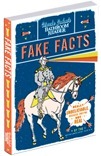 Want to read a whole book of fake facts?
Want to read a whole book of fake facts?
Then check out
Uncle John’s Fake Facts.
August 9, 2013
Odd Holiday: Chinese Valentine’s Day
It’s almost August 13: Have you bought your Magpie Festival face powder yet?
 The Western holiday of Valentine’s Day has its roots in a martyred Catholic priest who performed marriages when they were illegal. It also incorporates elements of Roman mythology, particularly Cupid, the Roman god of love.
The Western holiday of Valentine’s Day has its roots in a martyred Catholic priest who performed marriages when they were illegal. It also incorporates elements of Roman mythology, particularly Cupid, the Roman god of love.
China operates from different historical and mythological traditions, so it celebrates Chinese Valentine’s Day in a completely different way and at a completely different time. Instead of February 14, China has the Qixi Festival, or the Magpie Festival, celebrated in the summer, and this year it’s on August 13.
It’s an important holiday, especially for young and single women. It’s rooted in a 2,000-year-old Chinese legend involving star-crossed lovers. Zhinü, the seventh daughter of the Queen of Heaven, escapes the workshop where she’s forced to sew clouds all day. She then meets and falls in love with Niulang, a mortal, and a humble cow herder. They marry and have two children, but once the Queen of Heaven finds out, she orders Zhinü to return to her cloud-sewing station. Heartbroken, Niulang follows her to the heavens, Infuriated, the Queen digs a trench in the sky to separate Zhinü and Niulang permanently. However, once a year all the world’s magpies fly into the sky and form a bridge so that the two lovers can be reunited.
Today, the Magpie Festival is celebrated with trips to temples where young ladies pray to Zhinü for love tips and divine assistance with their sewing skills. The holiday is also popular among newlyweds who leave offerings of tea, flowers, and face powder out in their yards, in honor of Zhinü and Niulang. The day after the holiday, it’s a tradition for the couples to toss the powder onto the roof (for good luck in love). Western traditions have crept in, though—lovers also give each other flowers and chocolates.
August 8, 2013
The Wonderful World of Disneyland
Disneyland facts: amazing things you probably never knew about the Happiest Place on Earth.
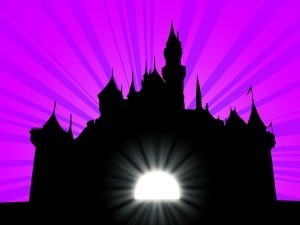 • The park has a large security force. It’s mostly undercover…but there are more Disney security officers than there are police officers in the adjacent city of Anaheim.
• The park has a large security force. It’s mostly undercover…but there are more Disney security officers than there are police officers in the adjacent city of Anaheim.
• Employee slang for being a costumed character: “duck duty.”
• In the Toy Story movies, the toys would all freeze and drop to the ground when their human owner Andy was approaching. If you yell “Andy’s coming!” when costumed Toy Story characters are out and about…they will freeze and drop to the ground.
• Disneyland’s streets and sidewalks are exceptionally clean. Part of that is because there’s a trash can every 30 feet or less, and the park’s concession stands don’t sell chewing gum. (Also, the streets are washed and steam-cleaned every night.)
• Richard Nixon loved Disneyland. When the Disney Monorail (the first regularly operating monorail in the Western Hemisphere) opened on June 14, 1959, Vice President Nixon was its first passenger. (And in November 1973, when Nixon was fighting off allegations that he was connected to the Watergate break-in, he gave his “I am not a crook speech” at Disney World.)
• If you’ve ever visited Disneyland, you’ve probably still got the repetitive “It’s a Small World” song stuck in your head. In fact, it’s such a hassle and takes too much time to turn off and turn back on the ride’s sound system each day that Disneyland never shuts it off. It literally plays all day and all night, nonstop.
• The future is green! All the plants in the futuristic Tomorrowland section of Disneyland are edible.
• Disneyland’s official address is 1313 Harbor Boulevard. Walt Disney was allowed to pick this out himself—M is the 13th letter of the alphabet, so “1313” equals “MM,” for “Mickey Mouse.”
• When the railroad ride around the park stops in New Orleans Square, listen carefully to hear a series of clicks and dashes. It’s a Morse Code rendering of the first few lines of the speech Walt Disney gave on the day the park opened in 1955.
• Disneyland first day, July 17, 1955, was a disaster. Open only to the media and a few handpicked guests, very little went right. A plumbers’ strike left drinking fountains nonfunctional and toilets clogged. The park ran out of food. The temperature was more than 100 degrees—so hot the asphalt melted. Most of these problems were cleared up by the next day, which is why in all internal Disney company materials, Disneyland’s “opening day” is listed as July 18, 1955.
August 7, 2013
Weird Invention: The Hovercraft Golf Cart
The new golf carts at a course in Ohio are a bit different than the old ones—for one thing, they fly.
 Most golfers dread hitting a water hazard, or hate to maneuver their golf carts around sand traps and other obstacles. But not the golfers at the Windy Knoll Golf Club in Springfield, Ohio. This summer, the course is unveiling two new hovercraft golf carts for their customers to use instead of the more conventional golf carts.
Most golfers dread hitting a water hazard, or hate to maneuver their golf carts around sand traps and other obstacles. But not the golfers at the Windy Knoll Golf Club in Springfield, Ohio. This summer, the course is unveiling two new hovercraft golf carts for their customers to use instead of the more conventional golf carts.
Windy Knoll will become the first course in America to offer BW1 Hovercraft Golf Carts. After seeing a video of PGA tour veteran (and 2012 Masters champion) Bubba Watson buzzing around in a prototype, the club’s management decided that hovercrafts were the future of golf, and that the future is now.
Watson helped Neoteric Hovercraft develop the idea for the BW1 after becoming frustrated with the limitations of normal carts. Each BW1s sells for $58,000—which seems pretty expensive for a golf cart…but extremely cheap for a hovercraft. While that might still give the golfing community sticker shock, the hovercrafts cause far less damage to courses than normal carts. The “footprint” of each vehicle is 33-times lighter than a human foot and, needless to say, much less destructive than wheels. They’re also capable of gliding above water hazards and sand traps, which would put a normal golf cart out of commission. On the other hand, the hovercrafts are larger than golf carts and require more maintenance, which is probably why Windy Knoll is charging $230 to rent one for a single round.
August 6, 2013
Secretary of Feedback (The Electras)
Richard Nixon played piano. Bill Clinton played sax. But it was a losing presidential candidate that may have made rock n’ roll history…accidentally.
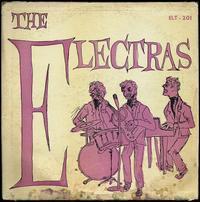 The Electras were one of thousands of garage rock bands formed by American high school kids in the early 1960s. More than 13 different guys played in the Concord, New Hampshire, band, all attending St. Paul’s School, an all-boys academy. One of the longest-serving members was bassist, future senator, current Secretary of State, and 2004 presidential candidate John Kerry.
The Electras were one of thousands of garage rock bands formed by American high school kids in the early 1960s. More than 13 different guys played in the Concord, New Hampshire, band, all attending St. Paul’s School, an all-boys academy. One of the longest-serving members was bassist, future senator, current Secretary of State, and 2004 presidential candidate John Kerry.
In late 1961, the Electras recorded an album of ten songs, mostly covers of well-known rock and pop songs like “Sleepwalk” and “Summertime Blues.” Only 500 copies were ever pressed, intended for friends and family—in 2004 a copy sold for more than $2,500 on eBay. That was the only thing the Electras ever recorded…until former band member Larry Rand discovered a reel-to-reel recording of the band playing live at a dance at the all-girls Concord Academy in October 1961.
They’d taken the gig to polish their sound before recording their album. The performance went well, right up until their tenth song, a cover of Link Wray’s “Raw-Hide.” The band, and those in attendance, were pained by a sudden, loud, screeching noise in the middle of the song. The rest of the Electras looked up and realized that bassist Kerry had inadvertently turned, with his instrument, and faced his own amplifier.
Thus the guitar distortion technique now known as “feedback” was born. The screeching, droning, raw, noise became a prominent and important part of rock history, through ‘60s psychedelic rock, and into punk rock and grunge. Rand believes it’s entirely possible that Kerry discovered feedback, and how startling it could sound in the middle of a performance. (However, a lot of other guitarists were experimenting in the same timeframe, and blues musicians in the ‘40s had fuzzy sounds…as did Link Wray, the musician Kerry and friends were covering at the time of the “discovery.”)
This story made the rounds when Kerry was running for president, and an Electras reunion was planned for 2005. But even though Kerry didn’t suddenly become very busy with presidential duties, the reunion never happened. Nor do you have to pony up a small fortune to hear Kerry’s high school band. You can download the album here.
August 5, 2013
Fabulous Flop: How Howard the Duck Changed Hollywood
George Lucas’ first big post-Star Wars project was an adaptation of a little-known comic book. Here’s the story of how Howard the Duck almost destroyed his career…
but led to the creation of a Hollywood goldmine.
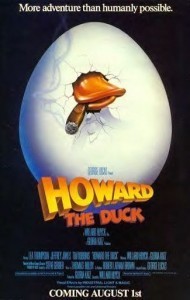 In 1983, George Lucas released Return of the Jedi, the final movie in the Star Wars trilogy, one of the most financially successful and popular film series of all time. But how would he follow it up? In 1985, Lucas announced that he was producing a movie adaptation of the Marvel Comics cult comic book Howard the Duck.
In 1983, George Lucas released Return of the Jedi, the final movie in the Star Wars trilogy, one of the most financially successful and popular film series of all time. But how would he follow it up? In 1985, Lucas announced that he was producing a movie adaptation of the Marvel Comics cult comic book Howard the Duck.
Today, Marvel movies are hot Hollywood properties—this year’s Iron Man 3 and last year’s The Avengers are among the top 20 highest-grossing films of all time. But the very first Marvel property to be made into a movie was Howard the Duck. It was about a humanoid duck from outer space living on Earth, and he was crass, rude, and sexist. Lucas had been trying to get a movie of it made since the mid-’70s, but no studio was interested. After the success of Star Wars, Lucas could make whatever he wanted and Universal readily agreed to distribute Howard the Duck. They needed a big movie for the summer of 1986, and they were still smarting from passing on the Indiana Jones movies, which Lucas had produced and which were distributed by rival Paramount.
Lucas hired Gloria Katz and Willard Huyck to write the screenplay—the three had written American Graffiti together in the early ’70’s. Katz and Huyck thought that the subject matter—a talking duck—lent itself more to being an animated movie. Universal said no—they had contracted Lucas to make a live-action film, as cartoon movies were not as popular or profitable at the time.
The film was rushed into production, and came out on August 1, 1986. And it was…not as well received as Star Wars, to say the least. Fans of the comic book were disappointed that the movie had strayed from the source material. Howard was no longer mean and outspoken—he was wry and silly and made lots of terrible duck puns (“I know Quack Fu!”). Howard’s human girlfriend Beverly, a nude model in the comic, was remade into a rock musician. It was marketed as a family film, but in spite of toning down the comic book, it was still loaded with sexual innuendo. The lead character was a $2 million animatronic and puppeteer-controlled duck costume, whose lips barely moved, and yet they still don’t quite match the dialogue. In fact, voice actor Chip Zien recorded all of his dialogue after the movie had already been shot.
Howard the Duck cost $37 million to make, and earned just $16 million in the U.S. At the time, George Lucas was in debt, having spent $50 million to build his Skywalker Ranch film production facility in California. He believed that Howard the Duck would make so much money that it would make him solvent again. (It didn’t.) Lucas had to sell off some of his assets. He sold his just-launched computer-animation division to his friend, Steve Jobs of Apple Computer.
And that studio became Pixar, responsible for movies like Toy Story, Cars, and Monsters, Inc. Today Pixar movies are as sure a box-office bet as any adaptation of Marvel Comics which, because of the Howard the Duck debacle, wouldn’t authorize another movie adaptation until 2002′s Spider-Man. It’s also worth noting that as of 2013, Lucasfilm, Marvel, and Pixar are all the same company—they’re all owned by Disney.
August 2, 2013
A Brand New State? The 51st State
There are fifty nifty United States…but who might be the 51st state? We don’t know, of course, but here are some real possibilities.
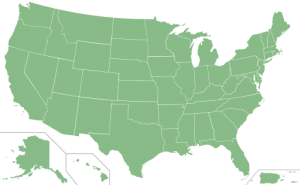 Puerto Rico? Puerto Rico sends a representative to Congress (although they don’t get to vote, and its residents pay federal income tax and may join the U.S. Armed Forces. Puerto Ricans are classified as U.S. citizens, but cannot vote in a presidential election. Reason: The island is a U.S. territory, not a state. At least not yet. In 2012, the island held a referendum regarding statehood. A whopping 61 percent of voters said they were in favor of becoming the 51st state, and legislation was drawn up and sent to President Obama and Congress in May 2013.
Puerto Rico? Puerto Rico sends a representative to Congress (although they don’t get to vote, and its residents pay federal income tax and may join the U.S. Armed Forces. Puerto Ricans are classified as U.S. citizens, but cannot vote in a presidential election. Reason: The island is a U.S. territory, not a state. At least not yet. In 2012, the island held a referendum regarding statehood. A whopping 61 percent of voters said they were in favor of becoming the 51st state, and legislation was drawn up and sent to President Obama and Congress in May 2013.
Washington, D.C.? The Founding Fathers thought it best, during the creation of the country, to make the seat of power separate from any state, to prevent any conflict of interest regarding state law vs. federal law. The movement for D.C. statehood picked up in 1980, when citizens approved a plan (and a constitution) to become a state called New Columbia—it failed because not enough of the states in the Union ratified the measure. A rallying anti-British protest cry before and during the American Revolution was “no taxation without representation.” Statehood advocates in the nation’s capital city drop the “no”—because they pay federal income tax and have no representation in Congress. There’s still a strong movement in D.C. for statehood, or at the very least, joining up with adjacent Maryland or Virginia.
North Colorado? The newest entrant in the 51st State Sweepstakes. In June 2013, commissioners from 17 counties in northeastern Colorado announced a plan to join together to separate from the rest of the state to form a new one. It would be the 42nd largest state in the country by population (and would include the major cities of Boulder and Fort Collins). The impetus of the movement began in Weld County, which has a wealthy reserve of oil and natural gas, and produces more revenue in those resources than it gets back in state services. Residents and politicians in the region are also generally more conservative than elsewhere in Colorado—secession talks began when the Colorado state legislature passed strict livestock treatment and gun control laws.
August 1, 2013
Legal Thriller: Michael Jackson vs. Paul McCartney vs. Sesame Street Parodies
The story of how Michael Jackson ruined a friendship but saved Sesame Street in the process.
 One of the reasons why Sesame Street has remained on the air for more than 40 years is because it appeals both to young children and the parents who watch it with them. And because producers know parents are watching, the show features guest appearances from stars that kids wouldn’t know but adults would, like Tina Fey or Jon Hamm, and educational songs that are parodies of well-known pop songs. In the ‘70s, for example, “Bruce Stringbean and the S. Street Band” performed “Born to Add,” a parody of Bruce Springsteen’s “Born to Run.”
One of the reasons why Sesame Street has remained on the air for more than 40 years is because it appeals both to young children and the parents who watch it with them. And because producers know parents are watching, the show features guest appearances from stars that kids wouldn’t know but adults would, like Tina Fey or Jon Hamm, and educational songs that are parodies of well-known pop songs. In the ‘70s, for example, “Bruce Stringbean and the S. Street Band” performed “Born to Add,” a parody of Bruce Springsteen’s “Born to Run.”
One of the most famous Sesame Street parodies ever: “Letter B,” a spelling-centric parody of the Beatles’ “Let It Be,” as performed in 1983 by a group of Muppet musicians with mop-top haircuts called “The Beetles.”
Under a copyright law called “Fair Use,” parodies may be recorded and released without securing permission from the song’s copyright owner. At the time “Let It Be” was controlled by a music publishing company called Northern Songs. In 1981, ex-Beatle Paul McCartney, along with Yoko Ono, widow of ex-Beatle John Lennon, attempted to buy Northern Songs, so McCartney and Lennon’s family could own the Beatles songbook. The deal fell through.
A couple years later, McCartney collaborated with Michael Jackson on the hit “Say, Say, Say.” Jackson had just made a ton of money from the success of his Thriller album and asked McCartney for financial advice. McCartney told him to invest in music publishing. Jackson did—in 1985, he purchased Northern Songs, and bought McCartney’s songs out from under him.
Jackson inherited one other thing from Northern Songs: a nasty lawsuit. Northern Songs was in the process of suing Children’s Television Workshop for $5.5 million. Reason: copyright infringement over “Letter B.” CTW is a nonprofit group, and a payout of that magnitude likely would have crippled the company and led to the end of Sesame Street, a beloved TV show around the world, and credited with helping millions of children learn to read.
While the purchase of the Beatles’ catalog permanently soured Jackson’s friendship with McCartney (they never collaborated or even spoke again), Jackson at least did one nice thing—immediately after the deal finalized in 1985, he cancelled the lawsuit. Children’s Television Workshop paid $50 to settle the case, which “Letter B” songwriter Christopher Cerf paid himself.
July 31, 2013
Food Facts: A Non-Vanilla Source of Vanilla
In the very near future, we might get vanilla from a source that sounds pretty gross, but is also incredibly environmentally friendly.
Do you love the way old books smell—musty and slightly smoky, but just a little bit spicy and sweet? (It’s what the BRI Headquarters smells like…really!) There’s actually a technical explanation for old book smell. It’s comes from a chemical called lignin, which is found in wood pulp. Wood pulp is used to make paper, and in that process, lignin gets exposed to air, or oxidizes. The oxygen in the air starts a chemical reaction in the lignin, and creates another chemical, called vanillin, which is one of the main compounds in vanilla. Old books smell slightly like vanilla, which scientists say is one of the most pleasing scents to the human nose.
 There are only a few ways to get vanilla. The first and most obvious source is the vanilla bean or pod. But they’re relatively rare (growing mostly only on the island of Madagascar) and, of course, expensive—vanilla beans cost about a dollar each in stores. Another way is to synthesize it in an industrial laboratory. Vanilla flavor can be obtained from a chemical combination of sodium hydroxide and sodium sulphide, or by processing a petroleum-based chemical called guaiacol.
There are only a few ways to get vanilla. The first and most obvious source is the vanilla bean or pod. But they’re relatively rare (growing mostly only on the island of Madagascar) and, of course, expensive—vanilla beans cost about a dollar each in stores. Another way is to synthesize it in an industrial laboratory. Vanilla flavor can be obtained from a chemical combination of sodium hydroxide and sodium sulphide, or by processing a petroleum-based chemical called guaiacol.
Neither process is particularly good for the environment, or for human consumption. But now there’s an alternative, using something the world has plenty of: wood pulp…as in sawdust. Using ionic liquids (liquid salts), two scientists at University Putra in Malaysia passed the lignin in wood pulp through bubbling water. Then, the salts helped them attract, identify, and collect the vanillin. It sounds gross but in other words, they’ve figured out a way to turn sawdust into a natural, virtually chemical-free source of vanilla. Theoretically, as long as there is wood and wood products, there could be a nearly unlimited source of vanilla. That is, if people can get over the fact that their lattes and cupcakes were flavored with sawdust.
July 30, 2013
Uncle John’s Bathroom Reader Wins ForeWord Awards
We are please to announced that we were honored at the ForeWord Reviews 2012 Book of the Year Awards.
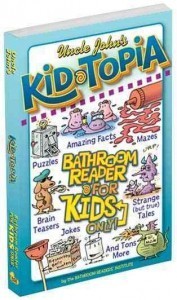 Uncle John’s KID-TOPIA Bathroom Reader For Kids Only! won Bronze in the Juvenile Nonfiction category.
Uncle John’s KID-TOPIA Bathroom Reader For Kids Only! won Bronze in the Juvenile Nonfiction category.
Uncle John’s Fully Loaded 25th Anniversary Bathroom Reader got an Honorable Mention in the Humor category.
Uncle John’s The Enchanted Toilet Bathroom Reader for Kids Only! was a finalist in the Juvenile Nonfiction category.
The ForeWord Awards program was designed to discover books from independent publishers across a number of genres. The final selections are made by librarians and booksellers based on their experiences with patrons and readers. Drawn from entries representing more than 600 publishers, the winners are selected after months of deliberation. This year there were 1,300 entries in 62 categories. Awards were determined by librarians and booksellers and announced at a special program at the American Library Association Annual Conference in Chicago on June 28, 2013.
Congrats to the whole team and to all our fans!



